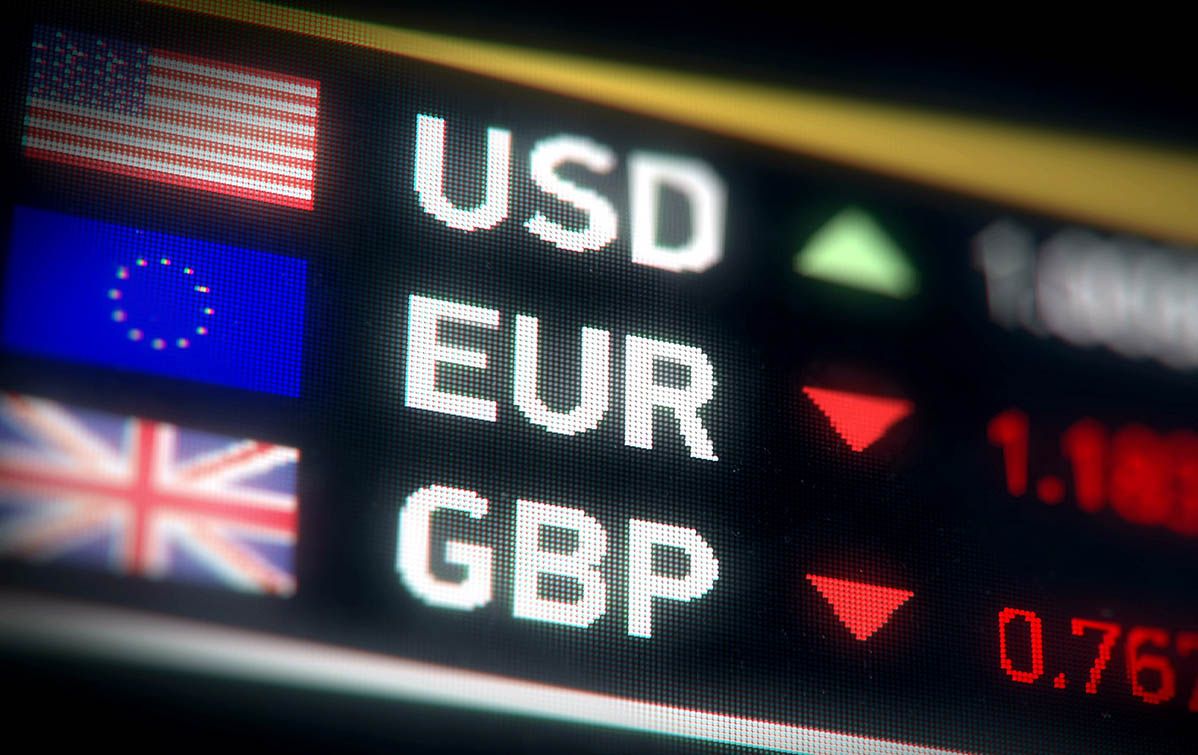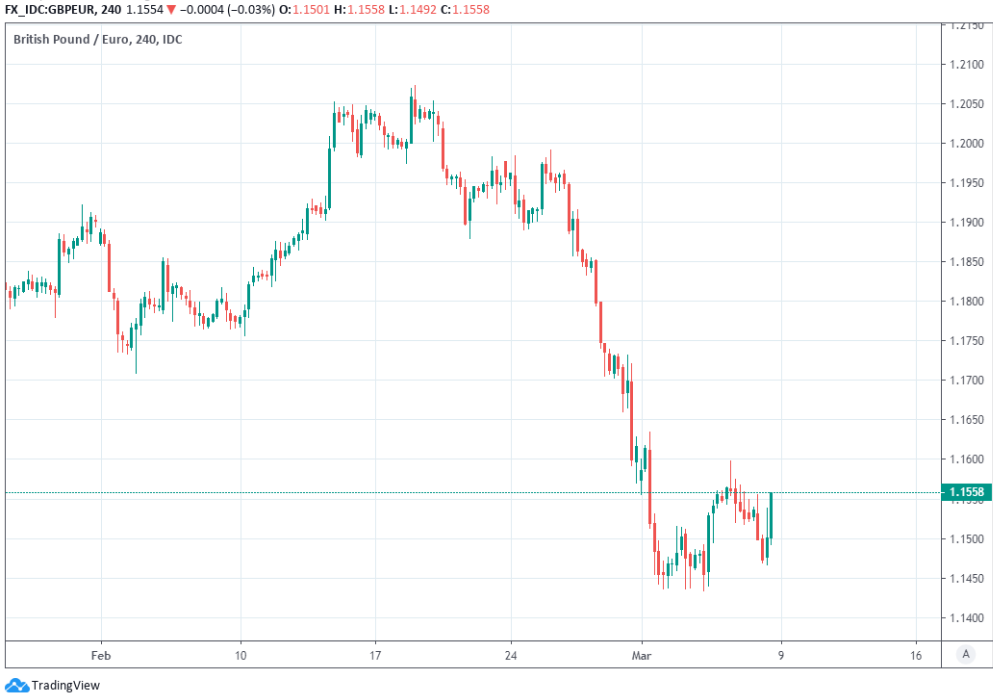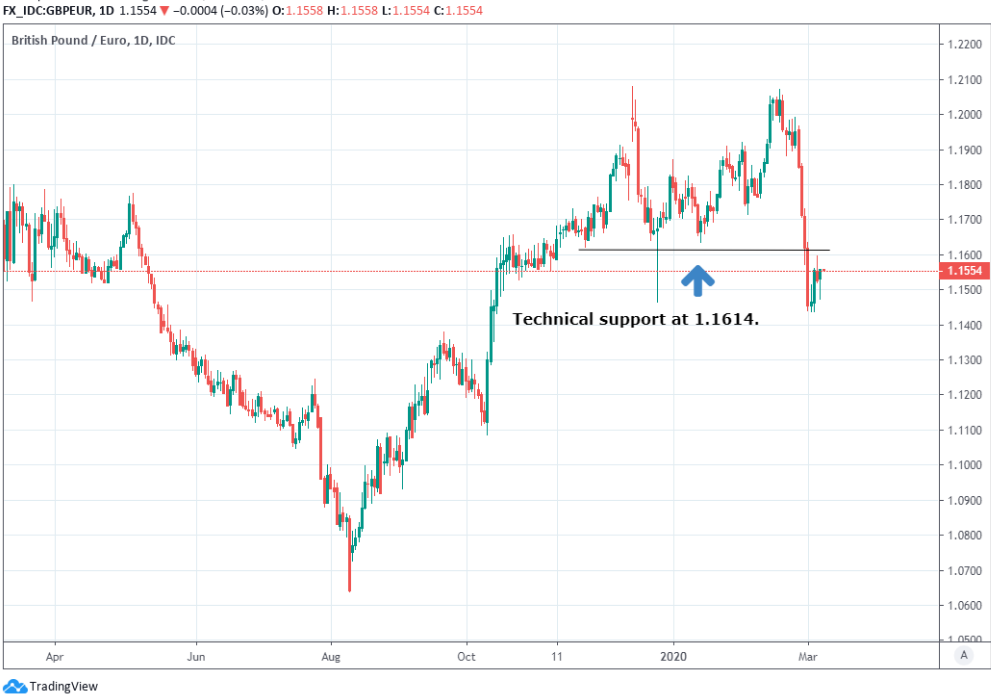The Pound-to-Euro Week Ahead: Charts Point Lower as Italian Lockdown Invites Turmoil
- Written by: James Skinner
- GBP/EUR trend has turned after loss of 1.1614 support.
- GBP may see short-term corrective move back to 1.1614.
- But failure to close above 1.1614 puts 1.1137 on the table.
- Coronavirus risk aversion to weigh on GBP ahead of budget.
- EUR faces market response to Italy quarantine ahead of ECB.
- Quarantine threatens IT economy, risks further market sell-off.
- EUR to keep benefiting from EM, equity position liquidations.

Image © Adobe Images
- GBP/EUR Spot rate: 1.1563, down -0.52% last week
- Indicative bank rates for transfers: 1.1258-1.1339
- Transfer specialist indicative rates: 1.1390-1.1459 >> Get your quote now
The Pound has suffered its fourth consecutive weekly loss to the Euro and fallen below a key technical support level on the charts in the process, undermining the multi-month uptrend in the Pound-to-Euro rate and exposing it to the risk of further declines up ahead.
Pound Sterling has been beaten into retreat by a rampantly strong Euro that's being lifted by the liquidation of 'carry trade' bets on higher yielding assets that are among the most vulnerable to risk aversion stemming from the coronavirus crisis. Last week's losses saw the Pound-to-Euro rate forced into a daily close below the 1.1614 level, which has underminied the post-summer uptrend and potentially set Sterling up for further declines up ahead.
Losses came as stock markets and commodity prices tumbled again while some major economy bond yields including those of the UK, US and Australia fell to new record lows as investors contemplated the likely impact the virus will have on the global economy.
What matters most now for the technical outlook is whether the Pound-to-Euro rate can reclaim the 1.1614 threshold on a closing basis. If it can then the exchange rate will have a clear run at 1.1782 but if it cant, then the next destination for Sterling could be the 1.1137 level not seen since early October.
"We are unable to rule out a slide back into the .8610/.8580 zone, but while above here the market remains bid. The market has recently completed a base with a .8979 upside measured target," says Karen Jones, head of techincal analysis for currencies, commodities and bonds at Commerzbank.
Above: Pound-to-Euro rate shown at 4-hour intervals.
Jones sold the Pound-to-Euro rate at 1.1554 last week and is looking for it to fall back to 1.1084 over the next one-to-three weeks, but says a corrective bounce back toward 1.1614 could happen first now that the exchange rate has tested its 200-day moving average 1.1437 three times and left it intact on each.
"Our intra-day studies are looking for at least a corrective pullback," says Robin Wilkin, a cross asset strategist at Lloyds Commercial Banking, of the EUR/GBP rate. "We monitor the nature of pullbacks as if they remain corrective, holding over that support we couldn’t rule out another leg higher".
Wilkin is also looking for the Pound-to-Euro rate to attempt to regain the 1.1614 level this week although he says that momentum will remain to the downside if Sterling cannot overcome it and that a move lower toward 1.12 will eventually play out in that scenario. And if Sterling does manage to reclaim 1.1614, then the technical stars would then be aligned for it to return to December's highs above 1.20 over the coming weeks.
However, any upward move in the Pound-to-Euro rate would require the GBP/USD rate to outperform the EUR/USD rate, which hasn't happened often in recent weeks because the Euro-to-Dollar rate has benefited amid the coronavirus market meltdown from the 'funding currency' status that had seen it borrowed and sold in brighter days in order to fund bets on higher yielding assets in the emerging markets and elsewhere. And it's tipped to continue benefiting as investors liquidate more of those bets.
Above: Pound-to-Euro rate shown at daily intervals.
AA
The Pound: What to Watch
The Pound underperformed all major rivals other than the U.S. Dollar and the commodity currencies last week and it might remain a laggard over the coming days given the large scale quarantine now in force in Italy, although Wednesday’s budget poses upside risks to Sterling.
Pound Sterling will spend the early part of the week preoccupied by the quarantine of an estimated 17 million people in the Lombardy region of Italy, which was announced by Prime Minister Giuseppe Conte in the early hours of Sunday morning. Around 14 provinces that are home to almost a quarter of the Italian population went into ‘lockdown’ Sunday and will remain subject to legal restrictions on the movement of people until at least April 03.
An emergency decree signed into law at the weekend requires that no citizens be able to enter or leave the affected areas and nor will they be able to move around inside the areas except for under certain circumstances. The government had already isolated some towns and villages in an effort to control a coronavirus epidemic that was unearthed a fortnight ago, although the weekend’s decree marks a significant expansion of the enforced isolation.
"Trillions of dollars of market capitalization have been lost in the past couple of weeks. Financial conditions have tightened. US, UK, and Australian bond yields have never been lower. The US 30-year bond yield has never been below 2%, and now it is below 1.5%. German Bunds yields are near record lows of near minus 75 bp. Investors seem to be concluding that the Federal Reserve is heading back toward the zero-bound," says Marc Chandler, managing director at Bannockburn Global Forex.
It’s exactly the above kind of containment measure that’s widely believed to have brought China’s economy to a standstill this quarter and it could be the case that Italy, which was already in recession, now faces a similar hit. The news unlikely to be welcomed by the Pound given that Italy is one of the UK’s top ten trading partners, and that’s even before markets get to wondering whether such measures will eventually be seen in other major economies like the UK and the U.S. as both battle their own outbreaks.
The UK government is for the time being dealing with far less than the 5,883 cases that were confirmed in Italy as of Saturday and partly for this reason it’s taken a softer approach to containment than Italy although a weekend of headlines reporting panic buying in the shops suggests members of the public are taking the threat of an outbreak seriously. That could have negative consequences for the economy if it leads consumers to shut themselves away indoors in order to avoid infection.
“The economy started the year on a strong note, but it is only a matter of time before it succumbs to the effects of the coronavirus. To reflect the weaker global backdrop and the likelihood that measures implemented to limit the spread of the virus will dampen business activity and spending by households, we have revised down our GDP growth forecast for this year from 1.0% to 0.7%,” says Paul Dales, chief UK economist at Capital Economics. “We also now expect the Bank of England to cut interest rates from 0.75% to 0.50% soon and the Chancellor to announce in the Budget on 11th March an extra package of measures to help support businesses and households.”
Dales forecasts a 02% increase in UK GDP for the first quarter followed by no growth in the second quarter as the economy suffers from efforts to limit the spread of coronavirus in the UK, which had 205 confirmed cases of it as of Saturday with two deaths. Measures taken in China during the height of its own outbreak turned cities of many millions desolate, exactly the same kind that were expanded in Italy at the weekend, and if replicated across the more than 90 countries battling the virus then the global economy could find itself in serious trouble.
Investors’ nerves have frayed of late as the disease spread further across the globe including in the U.S. and Europe, leading them to sell stocks and other risk assets en masse. Equity benchmarks are now in correction territory, oil is in a ‘bear market’ and major economy bond yields have hit record lows as investors sought the perceived safety of sovereign debt. And central banks including the Federal Reserve and Bank of Canada have responded with large 50 basis point interest rate cuts, although in the UK attention turns to the government this week.
“Fiscal policy will likely be the weapon of choice to accommodate the economic impact of the virus through measures such as the deployment of automatic stabilisers, targeted cash transfers (principally in health care) and/or allowing the spreading out over time of tax liabilities (the ‘time to pay’ measure announced this week),” says Abbas Khan, an economist at Barclays. “In the case of a COVID-19 major outbreak, we would expect the government to announce a boost in direct public spending commensurate with the extent of containment measures implemented. Of course, a prolonged pandemic could lead to debt-sustainability issues, if interest rates, already low, do not fall enough to offset a sustained primary budget deficit.”
Wednesday’s budget is the highlight of the week ahead for the Pound as far as the calendar is concerned and investors will be looking to see how the Treasury intends to support the economy as the government grapples with coronavirus. Markets had been briefed to expect a large stimulus in the budget which many had hoped would be enough to avert a Bank of England (BoE) interest rate cut this year after the economy slowed heading into year-end, and expectations relating to this were the main source of support for the Pound in February.
But the post-election ‘Boris bounce’ in confidence and output is now expected to give way to a virus-induced slowdown and as a result, investors are betting heavily that the BoE announces a rare 50 basis point interest rate cut to 0.25% on March 26. Pricing in the overnight-index-swap market implied on Friday, a 0.32% Bank Rate for March 26, which is close to the 0.25% that would prevail after a 50 basis point cut.
With the OIS implied Bank Rate at 0.32% the market is already pricing-in a substantial monetary response from the BoE, which might not be fully delivered if Wednesday’s budget does reveal a substantial fiscal stimulus. Incoming BoE Governor Andrew Bailey did say last week that he would like more evidence of a coronavirus impact on the economy before cutting interest rates at all, and if markets come to doubt the likelihood of that large March rate cut then the Pound might find itself back in favour with the market for a time.
The budget will be delivered in parliament by Chancellor Rishi Sunak at 11:30, just hours after the Office for National Statistics releases UK GDP data for January. Consensus is looking for the economy to have grown 0.2% that month, a slightly slower pace of growth than the abnormally strong 0.3% seen in December. The figures cover activity in the first full month after December’s election and will reveal whether there really was a Boris bounce in the economy after the Conservative Party’s landslide win.
“We assume that the BoE will look to hold off from an emergency rate cut, favouring a 25bp move at the scheduled meeting on 26 March, in the process leaving additional ammunition,” says Bipan Rai, North American head of FX strategy at CIBC Capital Markets. “The upcoming budget on 11 March will see a nicely timed fiscal boost. Evidence of precautionary measures to alleviate corporate liquidity pressures will likely add to GBP/USD impetus. Look for a close above the 100day MAV at 1.2991 to open the way for gains to extend towards strong resistance at 1.3070.”
AA
The Euro: What to Watch
The Euro outperformed all major rivals other than the safe-havens again last week as investors continued to liquidate earlier Euro-funded bets on higher risk assets, a trend that could continue over the coming weeks no matter what the European Central Bank (ECB) says or does on Thursday.
Europe’s single currency will be preoccupied early in the new week by the market response to a significant expansion of the Italian government’s coronavirus containment measures, which saw an estimated 17 million people placed under ‘lockdown’ at the weekend, up from just 50,000 previously.
The Italian government ordered in the early hours of Sunday that 14 provinces, which are home to around a quarter of Italy’s population, be placed under lockdown with nobody able to enter or leave the affected areas nor move around freely inside them.
Sunday’s emergency decree will bring significant disruption to Europe’s most fragile major economy and may prompt questions about whether such measures will eventually be seen in other major economies like the U.S., UK, France and Germany, which are also grappling with building outbreaks. The decree followed a decision from last Thursday to close all of Italy’s schools and universities until after March 15.
And it should really be bad news for the Euro, given the bloc’s already fragile economy although single currency was again lifted last week by the liquidation by investors of earlier bets on higher risk assets further afield, which were funded using Euros made super cheap to borrow by the European Central Bank’s negative interest rate. That position liquidation has lifted the EUR/USD rate more than 3% in the last month, as stock markets fell apart the world over and emerging market currencies tanked.
“The week ahead will see focus on the ECB’s response. It looks like the ECB didn’t want to play ball with a co-ordinated rate cut – genuinely believing lower rates would do more harm than good. This puts it in a tricky spot for next week’s ECB meeting. We think it wants to avoid a rate cut and instead will be looking at targeted measures to support corporate and SME lending, e.g. a TLTRO targeting the corporate sector. The lack of a ‘bazooka’ from the ECB may add to pessimism in risk assets (and pressure on the Fed to do the heavy-lifting with easing) and keep EUR/USD bid,” says Chris Turner, head of FX strategy at ING.
Coronavirus has spread to more than 90 countries, infecting more than 100,000 people and claiming more than 3,400 lives, and the disease has spread this last week with increasing momentum in Europe. It’s also spreading rapidly in the U.S. by many accounts, although the full extent of the problem is not known due to a lack of testing equipment at the state level. And as the problem grows larger investors could continue to mark down the global growth outlook, sell risk assets and bid for safe-havens.
The rising Euro is another headache for the ECB, which announces its latest interest rate decision at 12:45 Thursday, given that it risks exacerbating the chronic disinflationary condition of the Eurozone economy. A higher exchange rate can reduce import costs as well as consumer prices, which won't be at all welcome at an ECB that's already cut its deposit rate far below zero in the hope of stoking the faster growth necessary for it to sustainably deliver its target to ensure inflation of "close to, but below 2% over the medium term".
“To be clear, rate cuts and QE will not do much to help SMEs at this juncture but would likely increase the odds that we would see a stronger recovery once we are through the peak of the Coronavirus,” says Marchel Alexandrovich, an economist at Jefferies International. ”A package of measures focused on liquidity, interest rates and asset purchases, seems likely. What precise combination the ECB will choose will depend on how events unfold over the coming week (particularly the extent of the spread of the infection in the US) and whether what is currently taking place in Italy (in terms of school closures) is replicated in other parts of Europe.”
Consensus is looking for the ECB to leave all of its interest rates unchanged at 12:45 Thursday although the risk is the bank decides to cut the deposit rate and announce other measures that might include tweaks to its quantitative easing program or another round of cheap loans for banks to support Europe’s economy and lean against the rising Euro. But it’s far from clear that this will be enough to stop the Euro’s advance, which is being driven by investors exiting wagers on higher risk assets in a process that could continue for a while yet.
The ECB is highlight of economic calendar for the week ahead although there is also a range of other figures set to be released over the coming days including industrial production numbers for January and the second estimate of final quarter GDP, which economists see being revised up from 0.1% to 0.2% at 10:00 on Tuesday.
“Again we doubt that data will have much bearing at all on the FX markets. Instead investors will now also be focusing on the politicians. Do they passively allow fiscal stimulus by suspending budget rules in a slowdown or actively pursue spending to fill a hole in domestic demand? We expect 1.12 to prove good EUR/$ support now,” says ING’s Turner.






